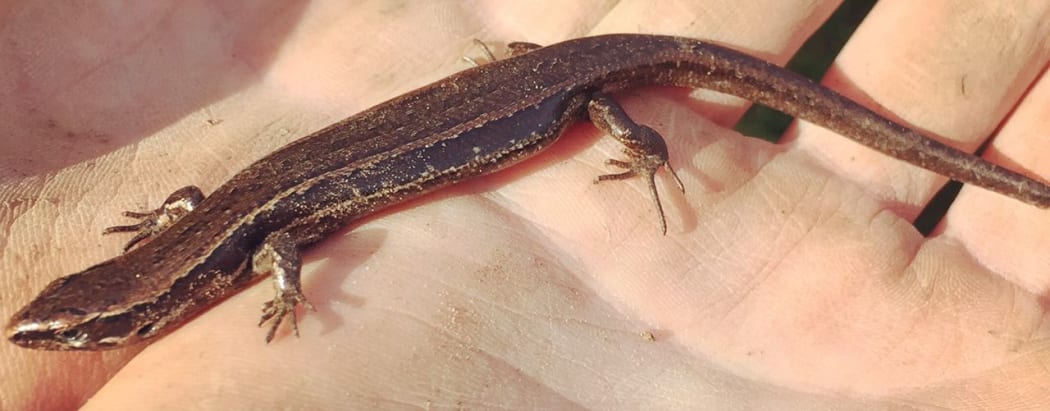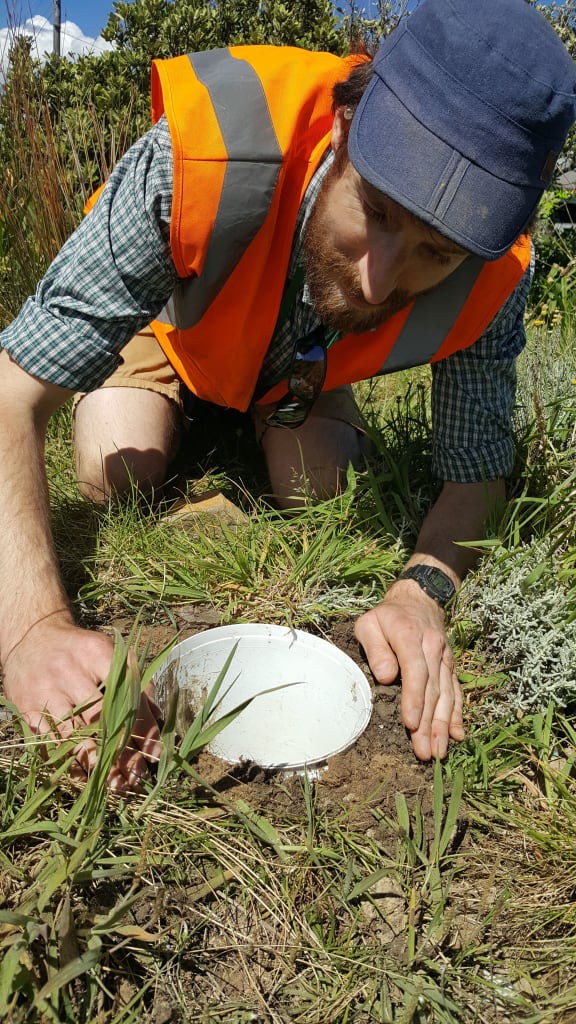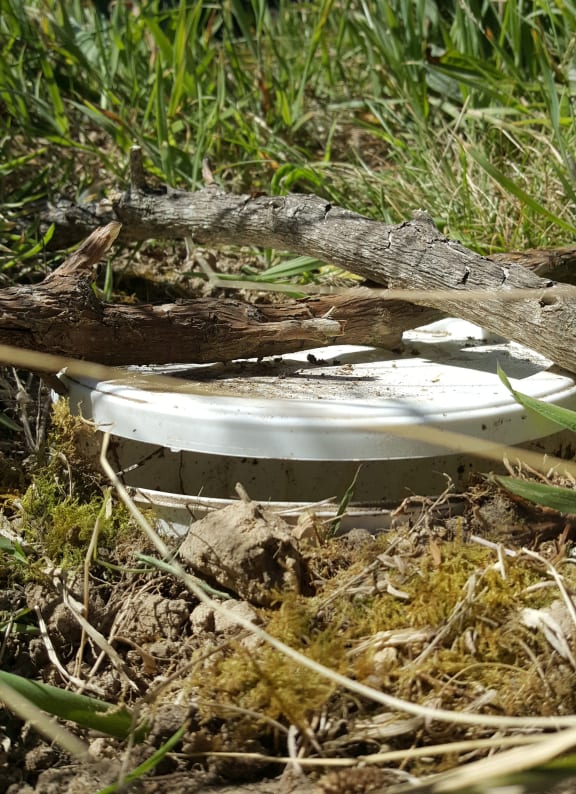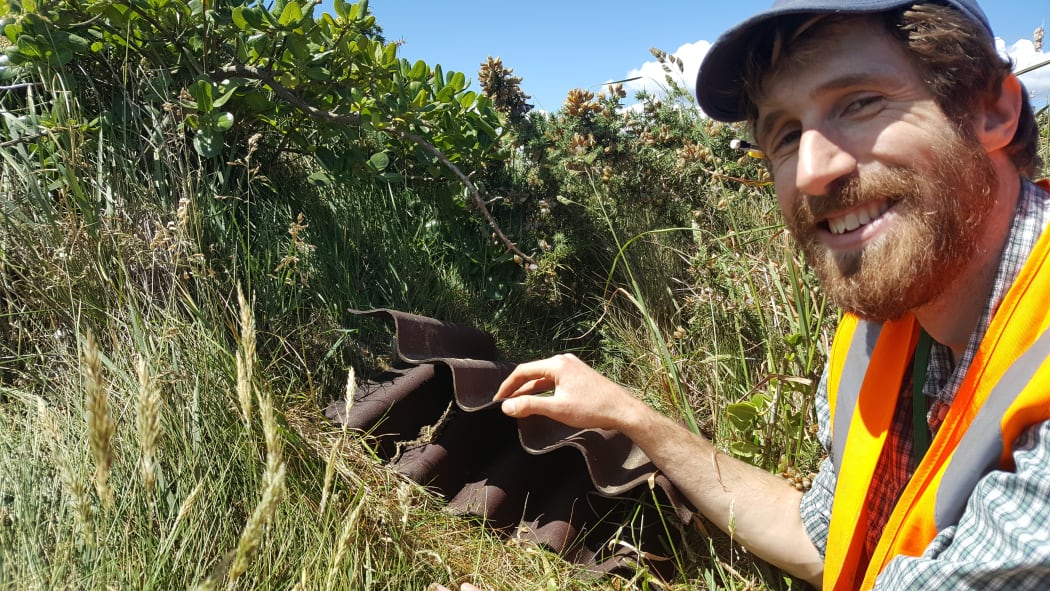It’s not much to look at, but a small area of rubbish-strewn, scrubby wind- and salt-blasted vegetation, sandwiched between Wellington Harbour and a busy road, is a surprisingly rich lizard hotspot. And researcher Chris Woolley is hoping he’ll be able to find just as many urban lizards in other cities across New Zealand.

A glossy brown skink (Oligosoma zelandicum) photographed in a Wellington garden. Photo: Chris Woolley / VUW
Subscribe to Our Changing World for free on iTunes, Spotify, Stitcher, RadioPublic, the RNZ App or wherever you listen to your podcasts.

Chris Woolley positions a pitfall trap into the ground, ready to catch lizards. Photo: RNZ / Alison Ballance
On a hot spring day, the roadside verge rustles with the sound of basking skinks slithering under nearby plants, as Victoria University of Wellington student Chris Woolley leads the way to a bucket dug into the soil, its lip flush with the ground.
The bucket is one of more than a thousand small white plastic pails that Chris has enlisted for his study, along with a keen band of citizen scientists. The aim? To find out what sorts of lizards are found in urban areas across the country, and measure how common they are.
The bucket has been turned into a pitfall trap, to temporarily hold any skinks that stumble into its depths. In the bottom of the bucket a piece of pear is a tempting lure, a damp sponge offers moisture, a handful of leaf litter provides somewhere to hide and a piece of folded wire mesh offers a safe retreat just in case a mouse also ends up in the trap.
Skinks are most likely to get caught in one of the pitfall traps, while geckos are more likely to be found hiding in one of the ACOs that Chris is also using as part of his study.

Wandering lizards fall into the pitfall trap, which is buried at ground level. The lid provides shade. Photo: RNZ / Alison Ballance
An ACO is an artificial cover object, a grand name for two pieces of corrugated Onduline roofing material sandwiched together and placed on the ground. The Onduline holds warmth, which cold-blooded lizards always appreciate.
Both the pitfall traps and the ACOs are simple - but effective – ways of finding out what kinds of lizards live in an area. Chris had only opened the pitfall traps about half an hour before I arrived, but already we discover a beautiful glossy brown skink calmly sitting in the bottom of one.
Chris explains that his study is only just kicking off, so this time he simply releases the skink, which darts under a nearby clump of tussock. But in future, he says, he plans to mark each individual skink at this site, so he can estimate how big the population is.
Chris says that there are four sorts of skinks and three kinds of geckos that Wellingtonians might record in their gardens, and other parts of the country will have different suites of species.
To find out more about lizards in New Zealand, check out the Atlas of amphibians and reptiles of New Zealand and the NZ Lizards Database.
People+Cities+Nature
Chris’s research is part of a much larger urban biodiversity research project, taking place in nine New Zealand cities.
People+Cities+Nature is led by Bruce Clarkson at the University of Waikato. It also involves researchers from Landcare Research, the University of Otago and Victoria University of Wellington. It is funded by the Ministry of Business, Innovation and Employment’s Endeavour Fund.

Chris Woolley checks to see whether any lizards - especially geckos - are sheltering in a stack of Onduline used as an artificial cover object. Photo: RNZ / Alison Ballance
Share your lizard sightings
As well as data from the citizen scientists who have already signed up for the research, Chris wants to collect as many sightings of skinks and geckos from around the country as he can at the Urban Lizard Locator.
The Department of Conservation also collects sightings as part of the Amphibian and Reptile Distribution Scheme.
Spotted skink translocation
Spotted skinks were translocated from Matiu Somes Island in Wellington Harbour to Zealandia ecosanctuary in early 2016 – Our Changing World was there to record the action.
Pacific Geckos in Shakespear Regional Park
Our Changing World joined lizard experts out at night, spotlighting Pacific geckos in north Auckland.
Wellington lizard hunt
New Zealand is known as the Land of Birds – but Land of Lizards is just as apt.


